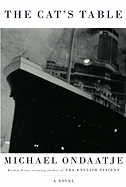
The epigraph for The Cat's Table is from Joseph Conrad's Youth, a tale told by Conrad's ubiquitous character, Marlowe, to his listeners: "And this is how I see the East.... It is all in that moment when I opened up my young eyes on it. I came upon it from a tussle with sea." So, too, does Ondaatje's 11-year-old narrator, Michael, in this lovely novel, come upon "it," at sea, on a liner sailing from Sri Lanka to England, where he will join his divorced mother. Like Conrad, Ondaatje arrived as an immigrant (when 11), first to England and later to Canada, mastering a new language along the way. This novel seems autobiographical, and yet, as with his "fictionalized memoir" Running in the Family, Ondaatje blurs the line between reality and invention.
And so the young boy begins a great adventure aboard the Oronsay. For meals, he's relegated to "the cat's table"; as a woman there tells him, "the least privileged place." But there he meets the quiet and thoughtful Ramadhin and the exuberant Cassius, a past schoolmate. Together, these three musketeers explore their new world and its inhabitants and make plans from the inner sanctum of the turbine room or under the lifeboat tarps where they feast on the food stored for emergencies.
Like Chaucer with Canterbury Tales, Ondaatje tells tales about people brought together on a trip (who they are, what secrets they keep), the children thus learning about adults and life "simply by being in their midst." Here are Max Mazappa, ship musician; Sir Hector de Silva, wealthy philanthropist seeking a cure; demure Miss Lasqueti and her "laugh that hinted it rolled around once or twice in mud"; the Australian girl who roller skates along the deck at dawn; the all-knowing Hyderabad Mind who performs evenings; the shackled, mysterious prisoner who is let out for late-night walks....
The Cat's Table is a paean to life, full of stories, wonderfully told. --Tom Lavoie, former publisher

